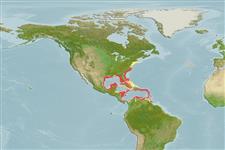Environment: milieu / climate zone / depth range / distribution range
экология
морской; солоноватоводный ассоциированный с рифами; мигрирует в океане (Ref. 51243); пределы глубины 30 - 100 m (Ref. 5222), usually 30 - 100 m (Ref. 5222). Subtropical; 41°N - 8°N, 98°W - 25°W (Ref. 5222)
Western Central Atlantic: Gulf of Mexico and east coast of US from North Carolina to Key West and along the southern shore of the Caribbean Sea. Juveniles are occasionally found as far north as Massachusetts.
Length at first maturity / Size / Вес / Возраст
Maturity: Lm 33.2 range ? - ? cm
Max length : 107 cm TL самец/пол неопределен; (Ref. 89707); common length : 30.0 cm TL самец/пол неопределен; (Ref. 3708); наибольший вес (опубликованные данные): 14.2 kg (Ref. 40637); наибольший возраст (опубликованны данные): 21 годы (Ref. 6846)
колючие лучи спинного плавника (общее число) : 11; членистые (мягкие) лучи спинного плавника (общее число) : 16 - 18; колючие лучи анального плавника: 3; членистые (мягкие) лучи анального плавника: 10 - 12. Distinguished by the following characteristics: four color patterns, first is brown phase with head and body pale brown covered with small reddish brown spots that extend onto median fins, second is cat's paw phase with pale brown body color with dorsolateral parts of body having several clusters of dark brown spots resembling the paw print of a cat, third is with large adults with grey-head phase with the rear two-thirds of the body dark, head and body anterior to the 6th dorsal-fin spine in silvery grey with dark reticulations and fourth is bicoloured phase with pale brown anteriorly and abruptly dark chocolate brown posteriorly; depth of body contained 3.0-3.4 times in SL; head length 2.6-3.0 times in SL; convex interorbital area; angular preopercle, angle with distinct bony lobe; serrate interopercle and subopercle; posterior nostrils of adults 2-4 times larger than anterior ones (Ref. 89707).
Found over ledges and high-relief rocky bottoms in the eastern Gulf of Mexico; at low-profile bottoms at depths of 30 to 100 m in North Carolina; this species was the most abundant grouper in areas of living Oculina coral formations at depths of 70 to 100 m off the east coast of Florida. This species apparently moved inshore when bottom temperature fell below 8.6°C. Juveniles found in shallow water at jetties and in mangrove areas.
Life cycle and mating behavior
половая зрелость | размножение | нерест | икра | Fecundity | личинки
Heemstra, P.C. and J.E. Randall, 1993. FAO Species Catalogue. Vol. 16. Groupers of the world (family Serranidae, subfamily Epinephelinae). An annotated and illustrated catalogue of the grouper, rockcod, hind, coral grouper and lyretail species known to date. Rome: FAO. FAO Fish. Synop. 125(16):382 p. (Ref. 5222)
Статус Красного Списка МСОП (Ref. 130435: Version 2024-1)
Угроза для людей
Harmless
Использование человеком
рыболовство: важный объект промысла; объект спортивного рыболовства: да
дополнительная информация
инструменты
Специальные отчеты
Скачать в формате XML
ресурсы в Интернет
Estimates based on models
Preferred temperature (Ref.
123201): 20.7 - 27.5, mean 24.4 °C (based on 130 cells).
Phylogenetic diversity index (Ref.
82804): PD
50 = 0.5000 [Uniqueness, from 0.5 = low to 2.0 = high].
Bayesian length-weight: a=0.00933 (0.00426 - 0.02047), b=3.05 (2.88 - 3.22), in cm total length, based on LWR estimates for this Genus-body shape (Ref.
93245).
Trophic level (Ref.
69278): 4.5 ±0.0 se; based on diet studies.
устойчивость к внешним воздействиям (Ref.
120179): низкий, минимальное время удвоения популяции 4.5-14 лет (K=0.09-0.17; tmax=21).
Fishing Vulnerability (Ref.
59153): High to very high vulnerability (69 of 100).
Climate Vulnerability (Ref.
125649): Moderate to high vulnerability (52 of 100).
Nutrients (Ref.
124155): Calcium = 11.7 [6.1, 26.2] mg/100g; Iron = 0.425 [0.208, 0.783] mg/100g; Protein = 19.6 [17.7, 21.3] %; Omega3 = 0.224 [0.128, 0.407] g/100g; Selenium = 18.8 [9.1, 37.6] μg/100g; VitaminA = 67 [18, 279] μg/100g; Zinc = 0.582 [0.373, 0.907] mg/100g (wet weight);
